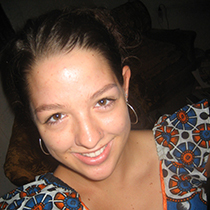
Lindsay Griswold participates in a dance as a Peace Corps Volunteer in Kenya in 2006.

Lindsay Griswold as a Peace Corps volunteer in 2006.
By Lindsay Griswold, Senior Specialist for Youth Exchange and Youth Protection
I grew up in a home that was not peaceful. So, I think peace is something I have always unconsciously sought, in my life, work, hobbies, and other interests. The summer after I graduated from university, I joined the United States Peace Corps, and served as a Deaf Education Volunteer in Kenya. This experience changed me in too many ways to count, but the traits I gained then that I still value now are patience, flexibility, and resilience.
Upon my return home, I served in AmeriCorps, worked as an educator, received my graduate degree in social work, and more. Each of these endeavors further ignited my passion for peace.
I continued this peace work when I began my career with Rotary International in 2014. Specifically, I work with Rotary Youth Exchange, one of the strongest on-the-ground peacebuilding initiatives we have here at Rotary. When Rotary announced a partnership with the Institute for Economics and Peace (IEP) in 2017, I was excited to see how it would be implemented across Rotary’s programs, including Youth Exchange. I completed the Rotary Positive Peace Academy when it first launched in 2018, and later learned about the IEP Ambassador program from a Rotarian who was in the first cohort. It seemed like a perfect fit.
Ambassadors participate in a series of online webinars representing the most comprehensive, data-driven analyses within the field of peace and conflict prevention to date. They are then required to put their knowledge to use by organizing a presentation or creative project for their network or community.
Rotary’s headquarters is in Evanston, Illinois, USA, but I have telecommuted from my home in Asheville, North Carolina, USA for the past few years while my spouse attends university. Initially, I designed my project as an in-person training at a Rotary Youth Exchange orientation session for inbound, outbound, and rebound students in the Asheville area (District 7670). Because Rotary Youth Exchange is a study abroad program, I planned to focus on the “good relations with neighbors” pillar of Positive Peace.
But then, the COVID-19 pandemic intervened. Social distancing and stay-at-home mandates were put into place, making an in-person presentation impossible.
Fortunately, I fell back on that flexibility I gained as a former Peace Corp volunteer. I pivoted my training toward a virtual audience of returned Peace Corps volunteers, focusing on the same pillar, but now analyzing our various countries of service through the lens of both the 2019 Global Peace and Positive Peace Indices.
The project ended up being the most meaningful part of the program for me, although at first, the idea of putting one together made me really nervous. What should I do? Who should I present to? Do I even know enough about Positive Peace to intelligently speak about the topic? When I had to change my plans, I became even more anxious. But because of that, I was motivated to work harder on a high-quality, interactive presentation that would be meaningful to my audience. I was truly grateful to speak with my peers about our shared but unique Peace Corps experiences, dust off my teaching skills, and communicate new ideas that sparked interesting conversations around Positive Peace.
As I look at the civil unrest gripping the U.S. and in places around the world right now, I am reminded of what I learned through the IEP Ambassador program. Peace is an inside-out job and the first sign of healing. I believe this applies to us as people and the nations in which we live. In order to activate Positive Peace, we must first start within ourselves and slowly move outward to our relationships, local communities, cities, states, provinces, countries, and the world.
Rotary has partnerships with both the Institute for Economics and Peace and the Peace Corps. Looking to get more involved with peace work? Take the Rotary Positive Peace Academy or become an IEP Ambassador.
https://blog.rotary.org/2020/06/18/peace-is-an-inside-out-job/
